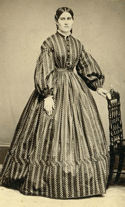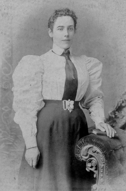| Victorian style and fashion is closely identified
with the reign of England's Queen Victoria, who ascended to the throne
as young girl in 1837 and remained sovereign until her death in 1901.
Before Victoria's reign, men were the focus of fashion, but with a
queen in power, women's fashions moved to the forefront and their
clothing styles changed dramatically over the 19th century.
In the pre-hoop era, from the 1840s to the mid
1850s, full skirts were supported by a vast array of petticoats. The
waist dropped on some bodices to slightly below the natural waistline.
Sleeves started out as plain and tight, but the wrist began to open and
by the end of the decade, had expanded into the pagoda sleeve,  a
style that in one form or another, would endure until the early 1870s.
There were both day and evening bodices for women, Daytime necklines
could be more open than those of later years, but evening bodices were
made with short tight sleeves and a very low decolletage, boldly
defying the demureness practiced during the day. Shawls were very
fashionable outerwear but the jacket bodice was quickly developing into
a more stylish alternative. a
style that in one form or another, would endure until the early 1870s.
There were both day and evening bodices for women, Daytime necklines
could be more open than those of later years, but evening bodices were
made with short tight sleeves and a very low decolletage, boldly
defying the demureness practiced during the day. Shawls were very
fashionable outerwear but the jacket bodice was quickly developing into
a more stylish alternative.
Skirts expanded as more and more petticoats were
worn. While the emergence of the crinoline in the mid-1850s, provided
freedom from all those layers, skirts which had previously reached
maximum width could to expand even farther. Flounces, rows and rows of
them, were added to the skirts, but the hardships of the Civil War
caused a decline in the amount of fabrics and trimmings used in
dressmaking. The excessive flounces became fewer and fewer and finally
disappeared.
During the 1860s, the skirt widths began to
diminish at the hips and the silhouette began to change to a smoother,
far more back-weighted design, so much so that it often had a train,
even for day wear. The skirts were often looped up for walking,
revealing a pretty petticoat.  The 1860s also saw a change to the bodice,
as the waistline began to rise above natural level. Before the decade
was over, the 'back' became the new focus of attention, with
overskirts, drapery and apron-like tunics adding to the volume,
creating the elaborate and slightly uncomfortable-looking silhouette.
By 1869, the hoop is replaced with the bustle. The 1860s also saw a change to the bodice,
as the waistline began to rise above natural level. Before the decade
was over, the 'back' became the new focus of attention, with
overskirts, drapery and apron-like tunics adding to the volume,
creating the elaborate and slightly uncomfortable-looking silhouette.
By 1869, the hoop is replaced with the bustle.
The early bustle era of the 1870s saw the short
and high waisted ordinary dress bodice soon descend to its natural
level, with the bottom of the bodice extending beyond the waist. These
figure-hugging bodices, created by the heavily boned corsets of the
day, started the new emphasis on the hour-glass figure. By 1873,
Bodices became longer and longer, and by 1873, the 'polonaise', a
bodice and overskirt in one garment, emerged.
Skirts were trained both for day and evening wear
and layers of petticoats were worn to keep the dress from trailing
through the dirt. Dust ruffles were often added to the added to the
inside of the train to help as well. While the bustle began to dwindle
in size,  the
excess fabric remained. A more vertical line started to appear and the
silhouette began to change subtly to a more natural form. after the
walking length skirt was re-introduced in 1878. the
excess fabric remained. A more vertical line started to appear and the
silhouette began to change subtly to a more natural form. after the
walking length skirt was re-introduced in 1878.
In the late 1870s, a tall, slim figure was
considered fashionable and each year, the skirts become narrower and
the bodices longer. Almost every dress is trained, including walking
dresses. Necklines for day wear become more conservative at the end of
the decade either open in a small 'V' or high with a collar.
By 1880, skirts are very slim and the train begins
to disappear. Theatre exerts an increasingly dominant influence on
fashion. Skirt draperies became more bouffant, especially behind, and a
new shelf-like bustle returns with a vengeance, and persisted until the
end of the 1880s. The bustle speedily went out of favor in 1889 and
almost overnight, a very slim, perpendicular silhouette emerged in
1890.
Late Victorian women embraced the sharper tailored
jacket fashion, giving them a different posture and more confident air.
Skirts in 1890 were cut in three to five gored panels,  narrow
at the top and wide at the bottom, or in the alternative, one-piece
circular 'umbrella' style. The bustle had disappeared, this time for
good. The waist remained as tight as ever as bodices continued to be
heavily boned. As the skirts became plainer, the focus switched to the
bodice, which began to explode with layers and frills. By 1896, sleeves
had reached their widest limit. Hats were very fashionable and their
popularity in the 1890s reached great heights. narrow
at the top and wide at the bottom, or in the alternative, one-piece
circular 'umbrella' style. The bustle had disappeared, this time for
good. The waist remained as tight as ever as bodices continued to be
heavily boned. As the skirts became plainer, the focus switched to the
bodice, which began to explode with layers and frills. By 1896, sleeves
had reached their widest limit. Hats were very fashionable and their
popularity in the 1890s reached great heights.
Towards the end of the decade, sleeves had slimmed
considerably and the corset shape had changed to the "S" curve, a
healthier alternative to the hour-glass silhouette. The bodice became
looser in front and pouched very slightly over the belt, showing
beginnings of the full breasted, pigeon look of the Edwardian period.
Skirts lost most of their stiffening and some of their width. Dresses
evolved into suits and the 'skirt and blouse' look was born. The brash,
gay nineties began to give way to something softer and more luxurious
as the Victorian age transformed into the Edwardian style in the last
years of the century.
|

